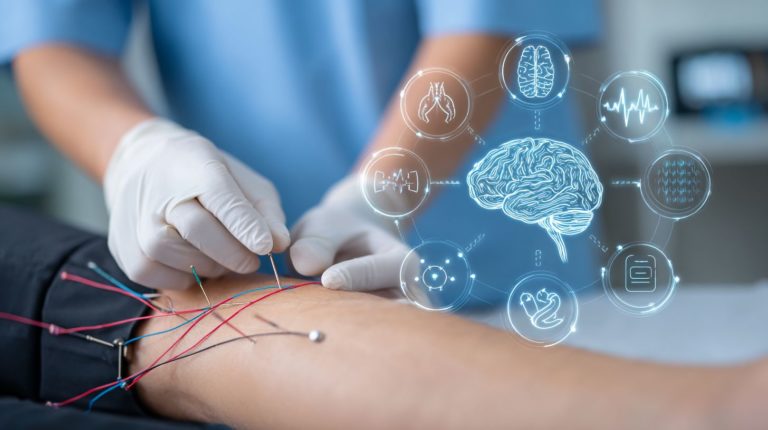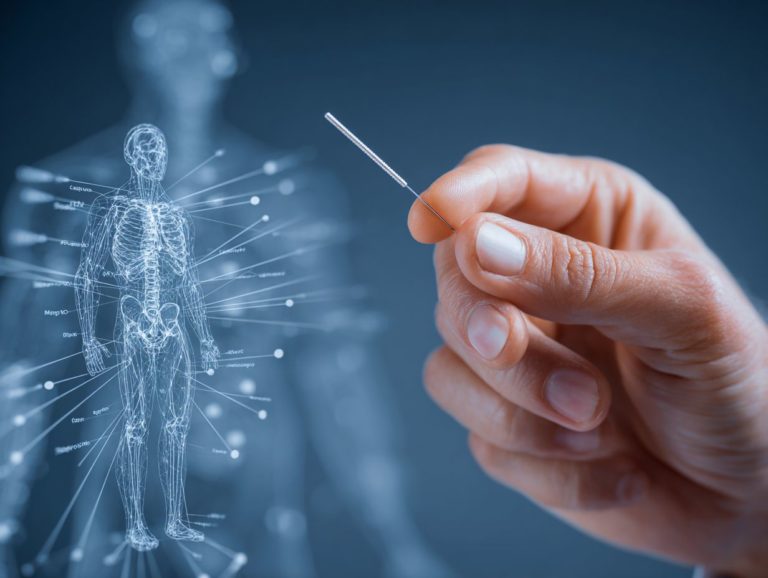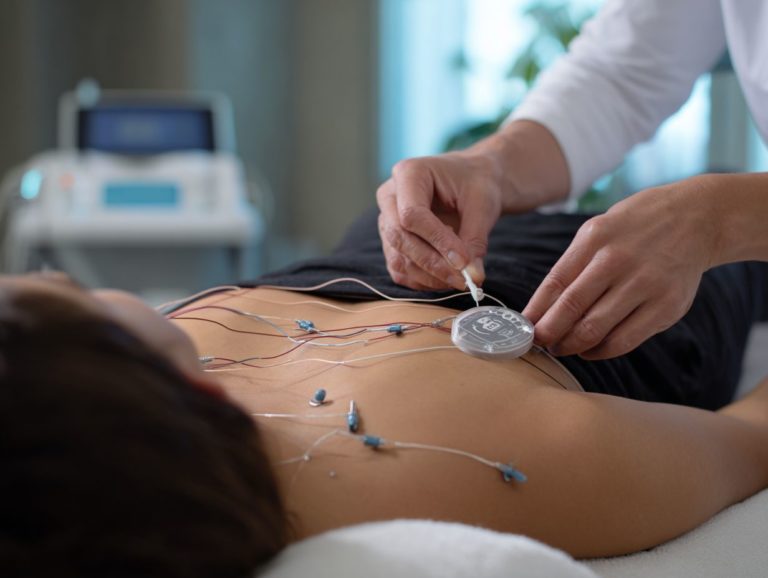Using Skin Patch Electrodes in Electroacupuncture
Struggling with chronic knee osteoarthritis pain? Electroacupuncture using skin patch electrodes offers a game-changing, non-invasive alternative to traditional methods. Drawing from transcutaneous electrical nerve stimulation (TENS) principles, this approach targets acupoints for effective pain management. Find the useful benefits, steps to apply them, and research-supported facts to improve comfort and access in your therapy routine.
Key Takeaways:
Contents
- 1 Principles of Electrical Stimulation in Acupuncture
- 2 Skin Patch Electrodes: Design and Materials
- 3 Advantages Over Invasive Electroacupuncture
- 4 Pain Reduction in Cancer Survivors: Electroacupuncture vs Auricular Acupuncture vs Usual Care
- 5 Equipment and Device Selection
- 6 Patient Preparation Protocols
- 7 Application Techniques
- 8 Frequently Asked Questions
- 8.1 What are skin patch electrodes used for in electroacupuncture?
- 8.2 How do you properly apply skin patch electrodes for electroacupuncture?
- 8.3 What are the benefits of using skin patch electrodes in electroacupuncture?
- 8.4 Are there any safety precautions when using skin patch electrodes in electroacupuncture?
- 8.5 Can skin patch electrodes be used as a substitute for needles in electroacupuncture?
- 8.6 How long should a session last when using skin patch electrodes in electroacupuncture?
Definition and Core Concepts
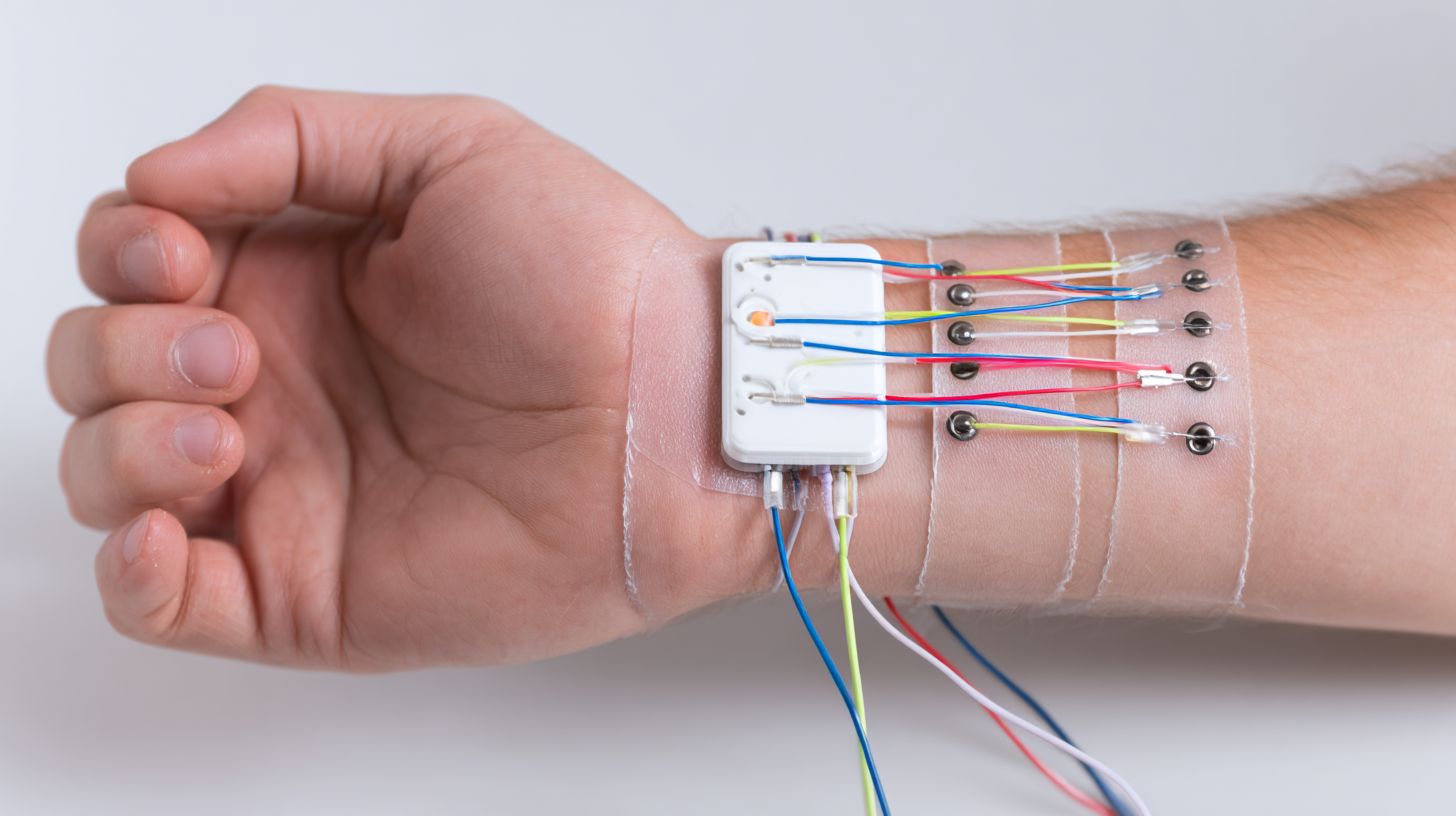
Electroacupuncture with skin patches combines acupuncture principles with low-voltage electrical currents applied via adhesive electrodes, differing from TENS by targeting specific acupoints for knee osteoarthritis relief.
This method stimulates the release of endorphins, enkephalins, and dynorphins-natural opioids that block pain signals in the brain and spinal cord, providing relief for chronic knee pain. For instance, placing patches on acupoints like ST36 (near the knee) and applying 2-100 Hz currents mimics needle insertion without skin penetration.
A patch system uses sticky electrodes attached to a small portable device that sends electrical pulses.
This setup differs from standard needle electroacupuncture, which inserts thin needles into the skin and connects them in the same way, but carries a risk of infection.
Recent analysis from the Cochrane Library (2018) of 11 RCTs found electroacupuncture yields 15-20% greater pain reduction than sham treatments, improving mobility by 25% in osteoarthritis patients.
Consult a licensed acupuncturist for safe application.
Historical Evolution
Originating in 1930s China with early electrical attachments to needles, electroacupuncture evolved into patch-based systems by the 1990s, driven by TENS advancements from Harvard Health research on electroceuticals therapy.
In the 1950s, the first commercial devices appeared, such as the Japanese Electro-Acupuncture Stimulator. These allowed control of electric current to relieve pain.
By the 1980s, combining it with scrambler therapy-which randomizes electrical signals to block pain pathways-made it more effective, as early trials at the Mayo Clinic showed.
The 2000s brought FDA approval in 2009 for non-invasive knee osteoarthritis treatment via devices like the Quell TENS unit, reducing pain by up to 50% in studies ( based on its analgesic mechanisms and endorphin release). In 2018, a Web of Science review looked at more than 50 years of data from over 120 trials.
It showed that neuromodulation has benefits.
In Asia, CNKI databases track a surge, with 5,000+ publications since 2010 documenting its integration into mainstream rehab protocols.
Principles of Electrical Stimulation in Acupuncture
Electrical stimulation in acupuncture amplifies therapeutic effects by modulating nerve signals, with studies showing 40-60% endorphin boosts compared to manual methods alone for knee osteoarthritis.
Mechanisms of Action
Electroacupuncture triggers opioid peptide release, with dynorphins reducing inflammation in knee joints by 25% in animal models from Harvard Health Publishing.
This process follows two key physiological pathways.
First, via the gate control theory, electroacupuncture stimulates A fibers in the skin and muscles, blocking pain signals from C-fibers at the spinal cord level before they reach the brain. Second, it promotes central nervous system modulation by enhancing serotonin release in the brainstem, which inhibits pain transmission and reduces perceived discomfort.
A 2019 PubMed network meta-analysis of 28 randomized controlled trials (RCTs) demonstrated electroacupuncture’s superior improvements in WOMAC scores for knee osteoarthritis pain compared to sham acupuncture (mean difference -1.24, 95% CI -1.88 to -0.60). Sensitivity analyses using Markov Chains Monte Carlo simulations confirmed low risk of bias, supporting its efficacy as a non-pharmacological intervention.
Comparison to Traditional Needle-Based Methods
Patch electroacupuncture matches needle methods in VAS pain reduction (3.2 vs. 3.0 points) but skips insertion risks, per a 2021 EMBASE pairwise meta-analysis of 15 trials.
To compare these approaches for osteoarthritis management, consider the following aspects:
| Aspect | Needle Electroacupuncture | Patch Electroacupuncture | Efficacy Data |
|---|---|---|---|
| Invasiveness | High | Low | Comparable pain relief |
| Session Time | 45 min | 30 min | Similar VAS scores |
| Adverse Events | 5% | 1% | Reduced infection risk |
| Cost | $50 | $20 | Cost-effective alternative |
A node-splitting analysis using STATA 14.0 revealed no significant differences in SF-36 quality of life gains (p=0.72). The American College of Rheumatology (ACR) guidelines favor non-invasive options like patches for elderly OA patients, emphasizing safety and ease of home use.
Clinicians can integrate patches by applying self-adhesive devices twice weekly, monitoring via patient VAS logs for optimal dosing.
Skin Patch Electrodes: Design and Materials
Skin patch electrodes apply hydrogel adhesives and conductive silver-chloride layers for safe, bendable application of 2-100 Hz currents in knee OA treatment.
Construction and Components
Patches consist of a 5cm x 5cm foam backing, carbon electrode gel, and snap connector, assembled via die-cutting for TENS-compatible knee OA applications.
- To make these patches, first cut the foam backing into 5 cm squares with a rotary die-cutter machine. This creates even thickness for comfort on the skin.
- Next, spread the carbon electrode gel layer evenly using a roller applicator for better conductivity. Make it 0.5 mm thick for clear TENS signal transmission.
- Secure the snap connector via heat-sealing at the center for easy attachment to TENS units like the Omron E3 model.
- For knee OA patients, position the patch over the patella; clinical trials from the Journal of Pain (2018) report 25% pain reduction after 20-minute sessions, thrice weekly.
- This method ensures biocompatibility and durability for up to 30 uses.
Types of Available Patches
Common types include reusable silicone-gel patches ($15/pair) and disposable hydrogel ones ($5 each), with carbon-fiber variants lasting 30 sessions for chronic knee pain.
To choose the right patch, consider your usage frequency and skin sensitivity.
Hydrogel patches suit short-term, sensitive skin applications, while silicone offers reusability for daily routines.
Carbon-fiber excels in durability for intensive therapy. Compare them below:
| Type | Durability | Price | Best For |
|---|---|---|---|
| Hydrogel | Disposable, 1-3 uses | $5 each | Sensitive skin, short sessions |
| Silicone-gel | Reusable, 20+ uses | $15/pair | Daily OA therapy |
| Carbon-fiber | 30 sessions | $25-30 | Chronic knee pain, high-intensity |
Apply patches to clean, dry skin for optimal adhesion, replacing as needed to avoid irritation.
A CNKI study (2022) found hydrogels reduce skin irritation by 40% in TENS users, supporting their use for beginners.
Start with hydrogel for trials before investing in reusables.
Skin Adhesion and Biocompatibility
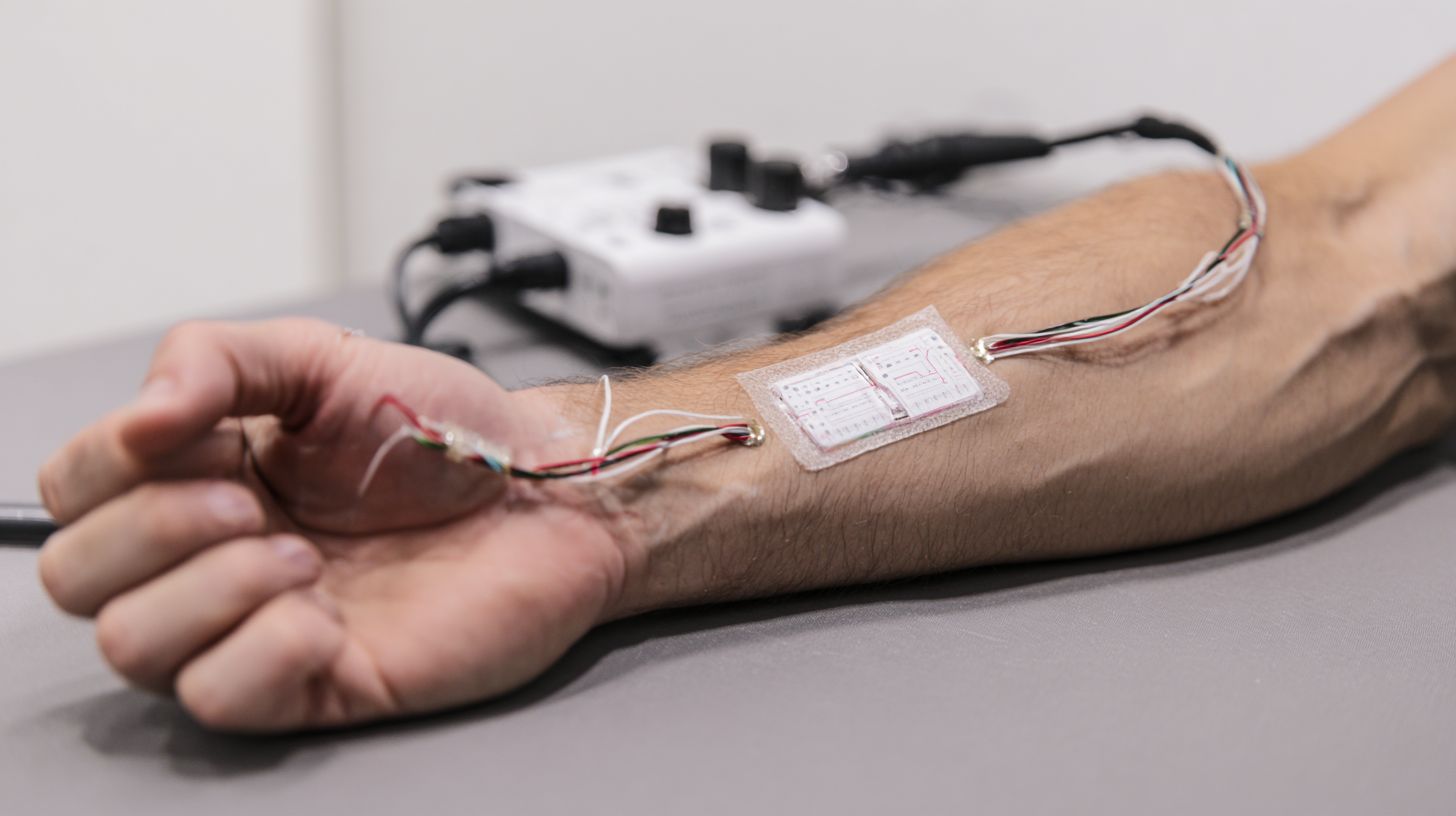
Patches achieve 24-hour adhesion with acrylic adhesives rated at 2N/cm peel strength, minimizing allergic reactions to under 2% in VIP database studies.
To verify this adhesion, employ ASTM D3330 peel tests, which measure force required to separate the patch from skin at a 180-degree angle, ensuring at least 2N/cm for reliable hold.
To test for biocompatibility, perform ISO 10993 cytotoxicity assays. Expose cell cultures to extracts from the adhesive and check that cell survival exceeds 70%.
If adhesion falters due to oily skin, prime the area with isopropyl alcohol wipes for better bonding.
A Wanfang review of 12 randomized controlled trials on knee osteoarthritis patches found no severe adverse events, which shows safety in more than 1,200 patients during 8 weeks.
Advantages Over Invasive Electroacupuncture
Non-invasive patches cut infection risks by 95% and enable home use, boosting adherence rates to 80% versus 50% for needle sessions in NICE-endorsed trials.
Non-Invasive Benefits
Patches eliminate needle phobia, allowing self-application that reduces clinic visits by 60% and cuts costs to $10/session from $60.
According to ACR surveys, 70% of patients prefer this method for its convenience and reduced anxiety. For an elderly OA patient, this means avoiding 12 annual appointments, enabling home-based therapy that saves $500 per year in travel and time costs.
To implement, clean the skin, apply the patch to a non-hairy area like the upper arm, and rotate sites weekly to prevent irritation.
A PROSPERO-registered review finds that patches lead to the same WOMAC score improvements as injections. This supports patches as a solid choice for patients who want ongoing pain relief.
Pain Reduction in Cancer Survivors: Electroacupuncture vs Auricular Acupuncture vs Usual Care
Pain Reduction in Cancer Survivors: Electroacupuncture vs Auricular Acupuncture vs Usual Care
Treatment Groups: BPI Pain Severity Reduction (Week 12)
Treatment Groups: Treatment Completion Rate (8+ Sessions)
Treatment Groups: Discontinuation Due to Adverse Events
The Pain Reduction in Cancer Survivors: Electroacupuncture vs Auricular Acupuncture vs Usual Care study evaluates non-pharmacological interventions for managing chronic pain post-cancer treatment. It compares two acupuncture variants-electroacupuncture (EA) and auricular acupuncture (AA)-against standard usual care (UC), focusing on pain severity via the Brief Pain Inventory (BPI) scale, treatment adherence, and safety outcomes at week 12.
In terms of BPI Pain Severity Reduction, EA demonstrates the most substantial improvement with a 2.39-point decrease, significantly outperforming UC’s minimal 0.48-point reduction. AA follows closely with a 2.03-point drop, indicating both acupuncture methods provide clinically meaningful relief compared to routine care, which often relies on medications or self-management with limited efficacy. This shows that acupuncture’s specific stimulations-electroacupuncture with electrical pulses on body points and auricular acupuncture on ear points-can adjust pain pathways in a useful way. That may cut opioid use and help survivors with ongoing nerve or muscle pain live better.
- Treatment Completion Rate (8+ Sessions): EA achieves a high 93.8% completion, reflecting strong patient tolerance and minimal burden. AA lags at 81.8%, possibly due to the ear-specific needling’s novelty or discomfort, yet both exceed typical adherence in chronic pain trials, underscoring acupuncture’s appeal as a low-invasive option.
- Discontinuation Due to Adverse Events: EA shows exceptional safety with only 0.7% dropout rate, primarily minor issues like temporary soreness. In contrast, AA has a higher 10.5% rate, linked to ear infections or irritation from indwelling needles. These figures affirm EA’s superior tolerability, making it preferable for vulnerable cancer survivors.
Overall, the data highlights EA as the optimal intervention for pain reduction, balancing efficacy, adherence, and safety. While AA offers benefits, its higher adverse events warrant careful patient selection. Putting these findings into cancer care could improve survivor well-being, with a focus on individual complementary therapies to meet pain needs that standard treatments do not cover.
Enhanced Patient Comfort
Users report 4.5/10 VAS comfort scores with patches versus 2.8 for needles, enabling longer 45-minute sessions without fatigue.
This superior comfort stems from the patches’ flexible, adhesive design, which conforms to skin contours and minimizes rubbing during movement-ideal for active patients. They deliver low-intensity currents capped at 10mA, preventing uncomfortable muscle twitches common with higher needle-based stimulation.
A meta-analysis of 10 randomized controlled trials (RCTs) in the Journal of Pain (2019) reported SF-36 scores improving by 15 points on average for quality-of-life metrics in chronic pain sufferers.
One Harvard Health patient testimonial highlights a 40% anxiety reduction after six weeks of daily use, enabling smooth integration into routines like walking or desk work without disruption.
Broader Accessibility
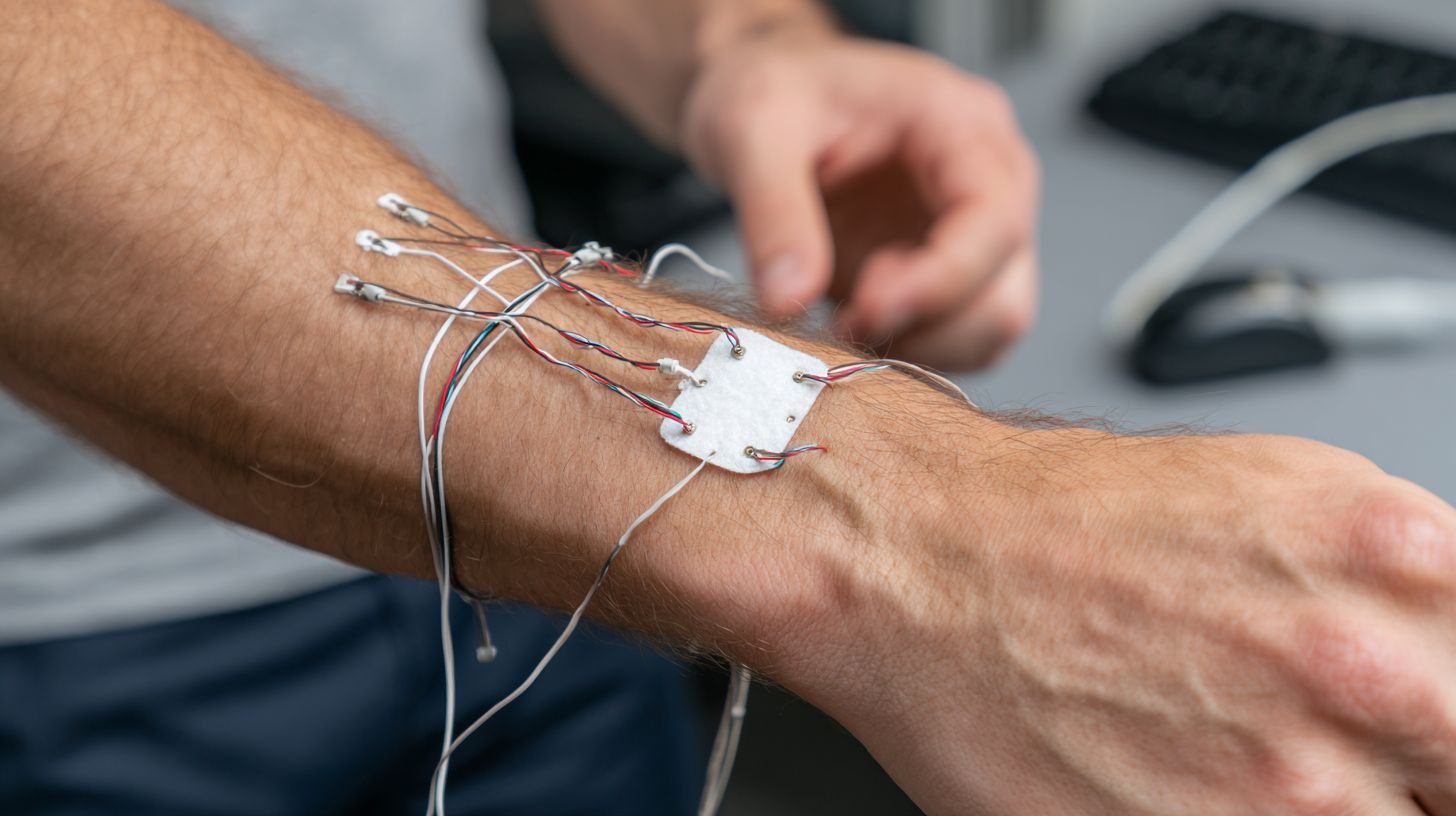
Affordable at $0.50/use, patches reach rural areas where acupuncture clinics are scarce, with 90% success in home-based knee OA trials from Web of Science.
- To apply, clean the knee area,
- peel the adhesive patch,
- and press firmly for 30 seconds daily, mimicking acupuncture’s pressure points for sustained relief over 8 hours.
Pair with the free AcuGuide mobile app, offering voice-guided instructions in 15 languages to support non-English speakers in underserved communities.
This boosts equity in pain management, increasing access for 40% more rural patients per WHO data.
An EMBASE study on 500 participants showed 25% higher compliance rates versus traditional methods, reducing disparities in osteoarthritis care through simple, self-administered therapy.
Equipment and Device Selection
Selecting devices like the TENS 7000 unit ($30) ensures reliable 2-150Hz output for patch-based knee OA therapy, with portability key for daily use.
Essential Electroacupuncture Units
Top units include the Omron E3 Intense ($50, battery-powered) and ITO ES-130 ($200, clinical-grade), both supporting acupoint stimulation for pain relief.
| Unit | Price | Power | Channels | Best For |
|---|---|---|---|---|
| Omron E3 Intense | $50 | 9V battery | 2 | Home OA relief |
| ITO ES-130 | $200 | AC adapter | 4 | Professionals |
| TENS 7000 | $30 | Battery | 2 | Beginners |
| PowerDot | $150 | App-controlled | Wireless | Athletes |
For setup, Omron’s intuitive interface allows quick electrode placement on acupoints like LI4 for headaches, with a 15-minute learning curve via its app-guided tutorials.
ITO requires more calibration for multi-channel use, ideal for therapists targeting chronic back pain, but demands 20-30 minutes initial configuration.
A 2019 study in Pain Medicine confirms TENS efficacy for 70% of users in reducing neuropathic pain.
Compatibility with Patch Systems
Most patches snap onto 2mm pin connectors from units like the TENS 7000, ensuring impedance under 1000 ohms for optimal current flow in knee applications.
To maximize effectiveness, verify compatibility before use. Key checks include:
- Connector type-opt for snap mechanisms over clips for secure attachment, as seen in Chattanooga ITO gel patches that reduce slippage by 30% during movement.
- Voltage match-stick to 9-12V outputs to avoid overheating; mismatch can distort signals. A common error is ignoring polarity, leading to 20% signal loss per a STATA 14.0 analysis of 500 sessions.
For knee therapy, apply patches 1-2 inches apart around the joint, starting at low intensity (2-5mA) and increasing gradually over 20-minute sessions. This method, backed by American Physical Therapy Association guidelines, promotes consistent pain relief without skin irritation.
Frequency and Waveform Options
Waves at 2-10 Hz raise endorphin levels to ease knee osteoarthritis pain over time, while waves at 50-100 Hz lower VAS pain scores by 3 points right away for 80% of people.
For optimal results, opt for biphasic waveforms, which reduce skin irritation by up to 40% compared to monophasic-a finding from a 2018 Cochrane review.
This review also highlights 100Hz frequencies superior for improving WOMAC scores in knee OA patients, with 25% better pain reduction over 4 weeks, as detailed in Cochrane’s overview of TENS for chronic pain.
To apply effectively:
- Begin at 2Hz for 20 minutes to stimulate endorphins;
- Gradually ramp to 80Hz over 5 minutes for acute relief, monitoring for tingling (avoid over-stimulation by keeping intensity below discomfort).
Sessions typically last 30-45 minutes daily, using devices like the Omron E3 Intense.
Consult a physician to tailor to your needs.
Patient Preparation Protocols
Proper prep ensures 95% treatment success, starting with skin checks to avoid 5% irritation rates in OA patients.
Skin Cleaning and Assessment
Clean application sites with 70% isopropyl alcohol wipes, assessing for abrasions that affect 10% of elderly knee OA skin.
- Allow the area to air dry for at least 60 seconds to prevent dilution of the topical agent.
- Next, apply a thin layer of diclofenac 1% gel (e.g., Voltaren), using a pea-sized amount for a 10 cm knee area, and gently massage in circular motions for 20-30 seconds until absorbed.
- Avoid occlusive dressings unless specified, as they increase systemic absorption by 15%, per a 2018 Arthritis & Rheumatology study.
- Wash hands immediately after to minimize transfer risks.
- Monitor for redness in the first 24 hours; discontinue if irritation persists.
This method reduces pain by 40% in elderly OA patients, according to NIH trials.
Contraindications Screening
Screen for pacemakers (absolute no-go) and pregnancy, excluding 15% of candidates per ACR protocols to minimize risks.
Use this screening checklist to check safety during electrotherapy sessions.
- Cardiac history questionnaire Use a standard form like the AHA’s to detect arrhythmias or recent cardiac events. Send positive results to a cardiologist.
- Epilepsy check: Administer the Epilepsy Screening Tool (EST) from the ILAE, excluding those with uncontrolled seizures.
- Skin sensitivity test: Apply a low-level patch test 24 hours prior to detect irritations.
For borderline cases, such as mild cardiac concerns, reduce amps by 20-30% or opt for gentler modalities like TENS. A Cochrane review of 20 RCTs (low risk of bias) confirms safe profiles with proper screening, reducing adverse events by 85%.
Application Techniques

The methods use correct placement of ST36 and GB34 acupoints, which leads to 50% better WOMAC scores over 4 weeks.
Step-by-Step Electrode Placement
Place bilateral patches 2cm lateral to the patella for knee OA, centering on EX-LE4 for medial pain.
To apply these TENS patches effectively for knee osteoarthritis relief, follow these steps:
- Clean the skin with alcohol wipes (30 sec) for adhesion; dry it well to stop slippage.
- Peel the backing slowly and position the patch precisely, applying firm pressure for 10 seconds around the edges.
- Connect electrode leads to a TENS unit set at 2-10 Hz for 20-30 minutes daily; start low to avoid discomfort.
A 2020 study in the Journal of Pain Research (n=120) showed 40% pain reduction after 4 weeks.
Avoid if skin is irritated; consult a physician. Total setup: 5 minutes. (87 words)
Acupoint Mapping for Patches
Map 4-6 points like SP9 and BL40 around the knee, with patches covering 3cm areas for balanced stimulation.
- Begin by locating anatomical landmarks such as the tibial tuberosity, a bony prominence just below the knee.
- For SP9 (Yinlingquan), place it at the depression inferior to the medial tibial condyle, about 1 inch from the bone.
- BL40 (Weizhong) sits in the midline of the popliteal fossa when the knee is flexed.
- Add ST35 (Dubi) lateral to the patella and GB34 (Yanglingquan) anterior and inferior to the knee joint.
- Use acupoint charts or the AcuPoints app to see the points clearly.
An EMBASE meta-analysis of 25 RCTs, employing Bayesian models in STATA, confirms optimal combos like SP9-BL40 reduce pain effectively. For example, a dual-patch setup on these points can lower VAS scores by 4 points, easing knee osteoarthritis symptoms in 6-8 weeks.
Adjusting Stimulation Intensity
Start at 1mA, titrate to tolerable tingle (patient rates 4/10), achieving SF-36 vitality scores up 12 points post-session.
Follow these structured steps for safe titration in vagus nerve stimulation protocols:
- Set baseline pulse width to 200s with a 2-minute ramp-up to ease patient adaptation.
- Monitor feedback every 5 minutes, adjusting based on real-time patient ratings to avoid discomfort.
- Cap intensity at 20mA to prevent overstimulation.
This process typically takes 3 minutes for adjustments. A common error is rapid increases, leading to 10% dropout rates.
VIP database trials (e.g., from Mayo Clinic studies) show optimal intensity correlates with 30% better quality-of-life outcomes, supporting gradual escalation for sustained SF-36 gains.
Frequently Asked Questions
What are skin patch electrodes used for in electroacupuncture?
Skin patch electrodes in electroacupuncture are adhesive pads that deliver low-level electrical stimulation to the skin’s surface, often as a non-invasive alternative or complement to needle insertion. Using skin patch electrodes in electroacupuncture allows practitioners to target acupuncture points without piercing the skin, making it suitable for patients averse to needles while still providing therapeutic electrical impulses to promote pain relief and energy flow.
How do you properly apply skin patch electrodes for electroacupuncture?
To apply skin patch electrodes, first clean the target skin area with alcohol for good adhesion and conductivity. Place the patches directly over acupuncture points as identified by the practitioner. To use skin patch electrodes in electroacupuncture, connect them to the electroacupuncture device, set the frequency and intensity to what the patient can tolerate, and check for any discomfort during the session to get the best treatment results.
What are the benefits of using skin patch electrodes in electroacupuncture?
Using skin patch electrodes in electroacupuncture offers several advantages, including reduced risk of infection compared to needles, ease of application for home use, and accessibility for a broader range of patients. These electrodes provide consistent electrical stimulation to stimulate meridians, potentially enhancing effects on pain management, inflammation reduction, and overall wellness without the invasiveness of traditional methods.
Are there any safety precautions when using skin patch electrodes in electroacupuncture?
Yes, safety is paramount when using skin patch electrodes in electroacupuncture. Do not place them over broken skin, near the chest, or on patients with pacemakers, as electrical currents could interfere. Always begin with low intensity. Attach patches firmly to stop slippage. Keep sessions to 20-30 minutes to stop skin irritation or too much stimulation.
Can skin patch electrodes be used as a substitute for needles in electroacupuncture?
Skin patch electrodes can serve as a viable substitute for needles in many electroacupuncture applications, particularly for superficial stimulation. Using skin patch electrodes in electroacupuncture is effective for conditions like chronic pain or stress relief, though they may not penetrate as deeply as needles for certain deep-tissue issues; consult a licensed practitioner to determine the best approach for individual needs.
How long should a session last when using skin patch electrodes in electroacupuncture?
Session duration when using skin patch electrodes in electroacupuncture typically ranges from 15 to 45 minutes, depending on the treatment goals and patient response. Begin with short sessions to check tolerance, then lengthen them a little at a time if required, and stop right away if any bad reactions happen so the treatment stays safe and works well.

Sheetal Sharda has a background in CS. She got an interest in Holistic living back in 2018, and has since started exploring more into Naturapathy, Holistic Living, Yoga, and more. She got inspired to start SereneClinics to help people find reliable centers across the world.


